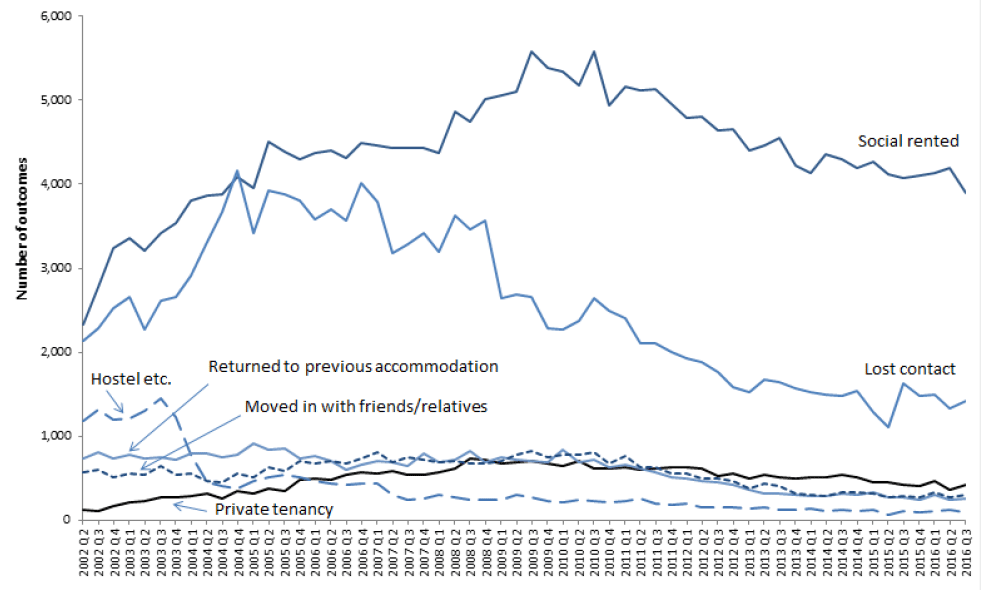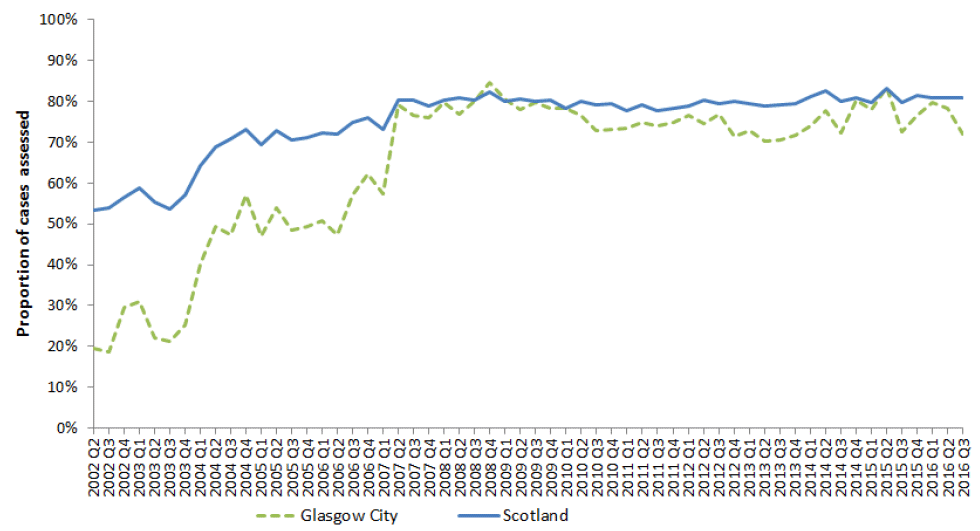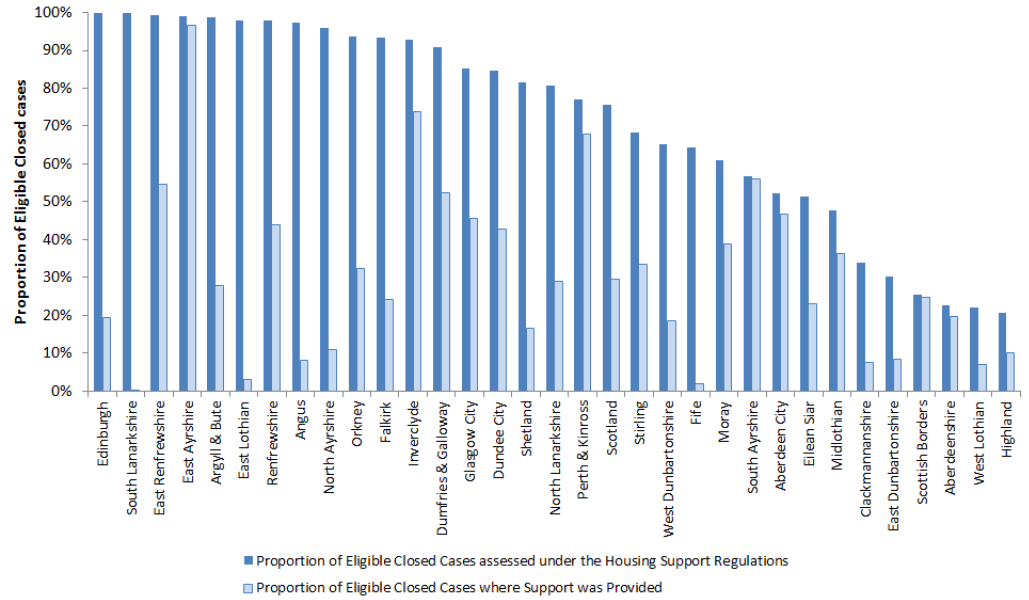Homelessness in Scotland: update to 30 September 2016
Information on homelessness applications, assessments and outcomes in the period to 30 September 2016.
This document is part of a collection
Outcomes
( Table 1 , Table 6 , Table 7 and Chart 4 to Chart 7)
Overall outcomes
Table 6 shows that, between 1 April and 30 September 2016, settled accommodation (private and social rented tenancies, including any non-permanent accommodation) was secured for 8,340 (81%) of the 10,312 applications where contact was maintained through to completion of the application. This proportion has remained stable for the past eight years (see Chart 4).
Chart 4: Percentage of cases assessed as unintentionally homeless [and in priority need], securing settled accommodation and where contact was maintained to duty discharge in Scotland, from April to June (Q2), 2002
![Chart 4: Percentage of cases assessed as unintentionally homeless [and in priority need], securing settled accommodation and where contact was maintained to duty discharge in Scotland, from April to June (Q2), 2002 Chart 4: Percentage of cases assessed as unintentionally homeless [and in priority need], securing settled accommodation and where contact was maintained to duty discharge in Scotland, from April to June (Q2), 2002](/binaries/content/gallery/publications/statistics-publication/2017/01/homelessness-scotland-update-30-september-2016/00512956.gif)
Social Lets
The number of homeless households securing a social let from either a Local Authority or housing association increased from around 2,500 in the April to June quarter in 2002 (Q2) to a peak of just under 5,600 in the July-September quarter of 2010 (Q3). The total number of social lets to homeless households has fallen back markedly from this peak and stood at almost 4,200 in April to June 2016, falling further to 3,900 in July to September 2016 (see Table 1 and Chart 5).
Chart 5: Outcomes of homeless applications in Scotland, from April to June (Q2), 2002

Note: Chart 5 includes outcomes for all applications, regardless of assessment decision or whether contact was maintained until duty discharge. Prior to April 2007, applications that withdrew prior to assessment are recorded together with lost contacts.
Outcomes for cases assessed as unintentionally homeless households
For the past eight years in Scotland, around 80% of cases assessed each year as unintentionally homeless have secured settled accommodation, and the latest six months is no exception - 81% of unintentionally homeless households secured settled accommodation between April and September 2016 (where contact was maintained until duty discharge) (see Table 6 ).
Over the same time period, and using Glasgow City as a highly populated example, the proportion securing settled accommodation reduced from a high of 85% during October to December 2008 (Q4), to a low of around 70% during April to June 2013 (Q2). The proportion securing settled accommodation increased to 84% during April to June 2015 (Q2) but lowered to 72% during the most recent quarter (July to September 2016) (see Chart 6). Glasgow City is a stock transfer authority where duty is discharged mostly in Registered Social Landlord ( RSL) accommodation.
Chart 6: Percentage of cases assessed as unintentionally homeless, securing settled accommodation and where contact was maintained to duty discharge in Glasgow City and in Scotland, from April to June (Q2), 2002

Notes: Other Local Authorities can be obtained using the chart slider in worksheet "Chart 6" in the "Publication Charts" spreadsheet.
Looking at all types of settled accommodation used during the past six months (April to September 2016), Table 6 shows that Local Authority accommodation comprises almost half (47%) of all outcomes for unintentionally homeless households, where contact was maintained. Over a quarter (26%) of unintentionally homeless households secured Registered Social Landlord ( RSL) accommodation and 2% secured non-permanent accommodation provided for the purpose of housing support. Private rented accommodation was taken up in 6% of cases.
Housing support regulations
The legislation which established the housing support duty (Section 32B of the Housing (Scotland) Act 1987 inserted by Housing (Scotland) Act 2010) states that there is a duty for Local Authorities to conduct a housing support assessment for applicants who are unintentionally homeless or threatened with homelessness and that they have 'reason to believe' need the housing support services prescribed in regulations.
'The regulations' are the Housing Support Services (Homelessness) (Scotland) Regulations 2012 and were established after public consultation. The services prescribed are:
(a) advising or assisting a person with personal budgeting, debt counseling or in dealing with welfare benefit claims;
(b) assisting a person to engage with individuals, professionals or other bodies with an interest in that person's welfare;
(c) advising or assisting a person in understanding and managing their tenancy rights and responsibilities, including assisting a person in disputes about those rights and responsibilities; and
(d) advising or assisting a person in settling into a new tenancy.
If an assessment of a need for support is made, Local Authorities must ensure the housing support services are provided. If this assessment is made, an assessment also needs to be made for others that reside with the applicant as part of their household.
The legislation states that 'housing support services' include any service which provides support, assistance, advice or counseling to an individual with particular needs with a view to enabling that individual to occupy, or to continue to occupy, residential accommodation as the individual's sole or main residence. The form and duration of housing support will vary depending on the individual's circumstances and/or those of the people in the household.
Assessments under the regulations and actual provision of support
Table 7 shows that, from 1 April to 30 September 2016, there were 12,724 cases assessed as unintentionally homeless or threatened with homelessness that were closed in this period. Of these, 9,633 (76%) were recorded as being assessed under the housing support regulations, and 3,754 were recorded as having had support provided (39% of those assessed under the housing support regulations).
There are large fluctuations across Local Authorities in the number who are making assessments under the regulations and the number to whom support is provided. Some authorities are making assessments for all their closed cases, particularly Edinburgh and South Lanarkshire. This is in contrast to other authorities who are recording very few assessments under the regulations, for example in West Lothian, Aberdeenshire and Highland. What appears to be even more variable is the extent to which support is then being provided: there are examples where nearly all those assessed have support provided (for example in East Ayrshire, Scottish Borders and South Ayrshire). Conversely, in South Lanarkshire and Fife, only a small proportion of those assessed under the regulations go on to receive support (see Chart 7).
Chart 7: Proportion of eligible closed cases assessed and with support provided under the Housing Support Regulations in Scotland, April to September 2016

Note: Eligible closed cases are defined as those assessed as unintentionally homeless or threatened with homelessness and that there is a 'reason to believe' that they need the housing support services prescribed in regulations. The original idea for this chart came from Scotland's Housing Network.
Contact
There is a problem
Thanks for your feedback